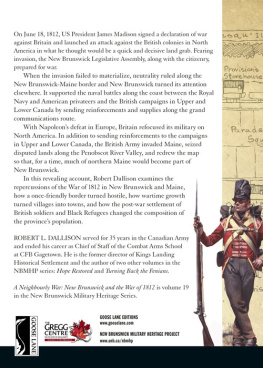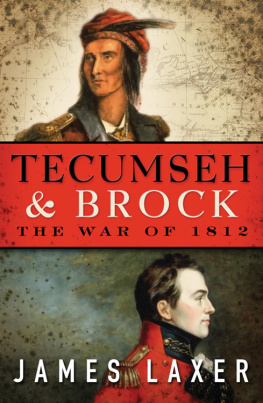Acknowledgements
I want to express my sincere appreciation to all those individuals, members of organizations, and staff of the institutions who contributed to this book with words of encouragement and support, suggestions, proofreading, and clues for further investigation.
First of all a very special thanks to those dedicated individuals who ensured that this publication emerged in a timely manner: Colin Agnew for his research, constant support, advice, and sense of humour I couldnt have done it without you; and the staff of Dundurn Press for their expertise, knowledge, and patience, particularly Kirk Howard, Michael Carroll, Jane and Barry Penhale, and Jennifer Scott.
Among those who made invaluable contributions are: Jane Beecroft, Oshawa; Dr. Carl Benn, Ryerson University; Valerie Buckie, Curator, Park House Museum, Amherstburg; June Chambers, Tecumseth and West Gwillimbury Historical Society; Janet Cobban, Curator, John R. Park Homestead Conservation Area; Lynne Campbell and Kathryn Harvey, Guelph McLaughlin Archives, University of Guelph; Paul Delaney, Tiny, Ontario; Madelyn DellaValle, Curator, Windsors Community Museum; Pat Fillion, Black Creek Pioneer Village, Toronto; Kathy Fisher and Pauline Pennett, Ermatinger Clerque National Historic Site, Sault Ste. Marie; Dr. Rae Fleming, Argyle, Ontario; Emily Gibson, Toronto; Debra Honor, Amherstburg; Jeanne Hopkins, Willowdale; Joyce Horner, Town of Markham; Jeanne Hughes, Richmond Hill; Edward Janiszewski, Toronto; Ruth Keene, Niagara Falls; Linda Kelly, Sheguiandah, Manitoulin Island; Carolyn King, Mississaugas of the New Credit First Nation; Kenneth Kidd, Features Writer, Toronto Star ; Rosemary Kovac and Mya Sangster, Fort York National Historic Site; Robert Leverty, The Ontario Historical Society; John MacLeod, Fort Malden National Historic Site; Judith McGonigal, Sault Ste. Marie; Brian Narhi, St. Catharines; Lori Nelson and Lisa Moncrief, Lake of the Woods Museum, Kenora; Janice Nickerson, Upper Canada Genealogy, Toronto; Michael Nickerson, Toronto; David OHara, Administrator, Fort York National Historic Site; Stephen Otto, Friends of Fort York and Garrison Common; Dennis Pollock, Beaverton, Ontario; Joyce Pettigrew, Otterville, Ontario; Douglas Robinson, Chatham-Kent, Ontario; Nancy Scott, Sault Ste. Marie; Lorne Smith, Historian, Town of Markham; Margaret and Harley Teare, Niagara-on-the-Lake; Jane Teeple, Amherstburg; Chris Tomasini and Kim Vallee, Lakehead University Library, Orillia Campus; Elizabeth Tucker, McGregor, Ontario; George Waters, Friends of Fort York and Garrison Common; Bridget Wranich, Program Officer, Fort York National Historic Site; Marianne and Dennis Yake, descendants of militia member Daniel Yake; members of Fort Malden Volunteer Association; Orillia Public Library staff; and the Toronto Public Library staff.
Introduction
Setting the Stage
W hen the American Revolution ended with the signing of the Treaty of Versailles in 1783, it ceded to the new republic of the United States the western country from the Allegheny Mountains to Lake of the Woods. The treaty was considered a disaster, not only to those who remained loyal to King George III and Queen Charlotte but to the First Nations, the military, and the fur traders.
Why a disaster? The First Nations had been negotiating to have a large area in the Old Northwest (south of Lake Erie and north of the Ohio River) declared a buffer between Quebec (later Upper and Lower Canada) and the new republic. The fur traders supported this plan since the settlers and their settlements were destroying the fur trade in the area. For those who had remained loyal to Britain, they had lost everything homes, farms, businesses and were forced to find refuge in a new homeland.
In 1783 and 1784 it is believed fifty thousand refugees streamed into the remaining British colonies to the north. These included Newfoundland (Englands oldest colony), le Saint-Jean (Prince Edward Island), Nova Scotia, and Quebec.
This vast area had been the home of the First Nations from the beginning of time, with Britain and France struggling for control of both the territory and its rich resources. Military forts, fur-trading posts, and a chain of settlements stretched along the waterways in Nova Scotia and Quebec from the Atlantic Ocean to Lake Huron. Behind the settlements in Quebec were dense forests, and beyond lay Ruperts Land, so named since May 2, 1670, when King Charles II of England granted his cousin Prince Rupert a royal charter that gave trading rights in the area stretching from Lake Huron north to Hudson Bay, and west to the Pacific Ocean (approximately 40 percent of present-day Canada and part of the United States). The coveted trading rights were for furs, particularly beaver pelts.
The arrival of this enormous group of refugees who were not sojourners but settlers was to have a profound effect on a land that was already in transition. They were both Natives and newcomers, and became known as the United Empire Loyalists. Their arrival led to the partition in 1784 of the old colony of Nova Scotia into three new colonies: New Brunswick, Cape Breton Island, and a smaller Nova Scotia. Meanwhile, thousands walked north and arrived near Montreal, leading to the division of Quebec into Upper and Lower Canada in 1791.
Long before the arrival of the Loyalists, a web of human relationships had already developed among the First Nations, explorers, fishermen, fur traders, entrepreneurs, missionaries, military, government officials, merchants, and settlers fuelled by friendship, marriage, respect, business, religion, and proximity. Now a new and strong strand was added to the landscape and to the communities developing there.
Hoping for the Best, Preparing for the Worst explores the everyday lives of those trying to survive and prosper in this sparsely populated land of astonishing harshness, beauty, and bounty in the years leading up to the War of 1812 and during the conflict. To understand the conflict it is important to travel back to the end of the American Revolution, for the seeds of the War of 1812 first sprouted there and developed over the years as implications of the Treaty of Versailles and the American lust to expand became apparent to Upper Canadians. In the intervening years the republic and its neighbour, Upper Canada, developed in very different ways, and we explore events in Upper Canada in the opening chapters as the stage is set for the conflict.
We begin with the arrival of the Loyalists, for they were determined to put down roots, clear forests, develop farms, open shops for trade, barter, and business, or practise their professions. The men and their sons expected to plant and harvest crops, grind grain into flour, make and repair harnesses, shoes, and tin and ironware, and use all the skills they brought with them. Their mothers, wives, daughters, and sisters expected to plant, harvest, and preserve their gardens and orchards, spin and weave textiles, make medicines and meals from local ingredients, and care for their families. They were not expecting war on their fields and in their forests, their homes and barns converted to hospitals, or days spent burying the dead in unmarked graves. In just over two decades those who sought refuge in Upper Canada found that they were at war again, with all the unexpected horror that it was to bring into their lives.






